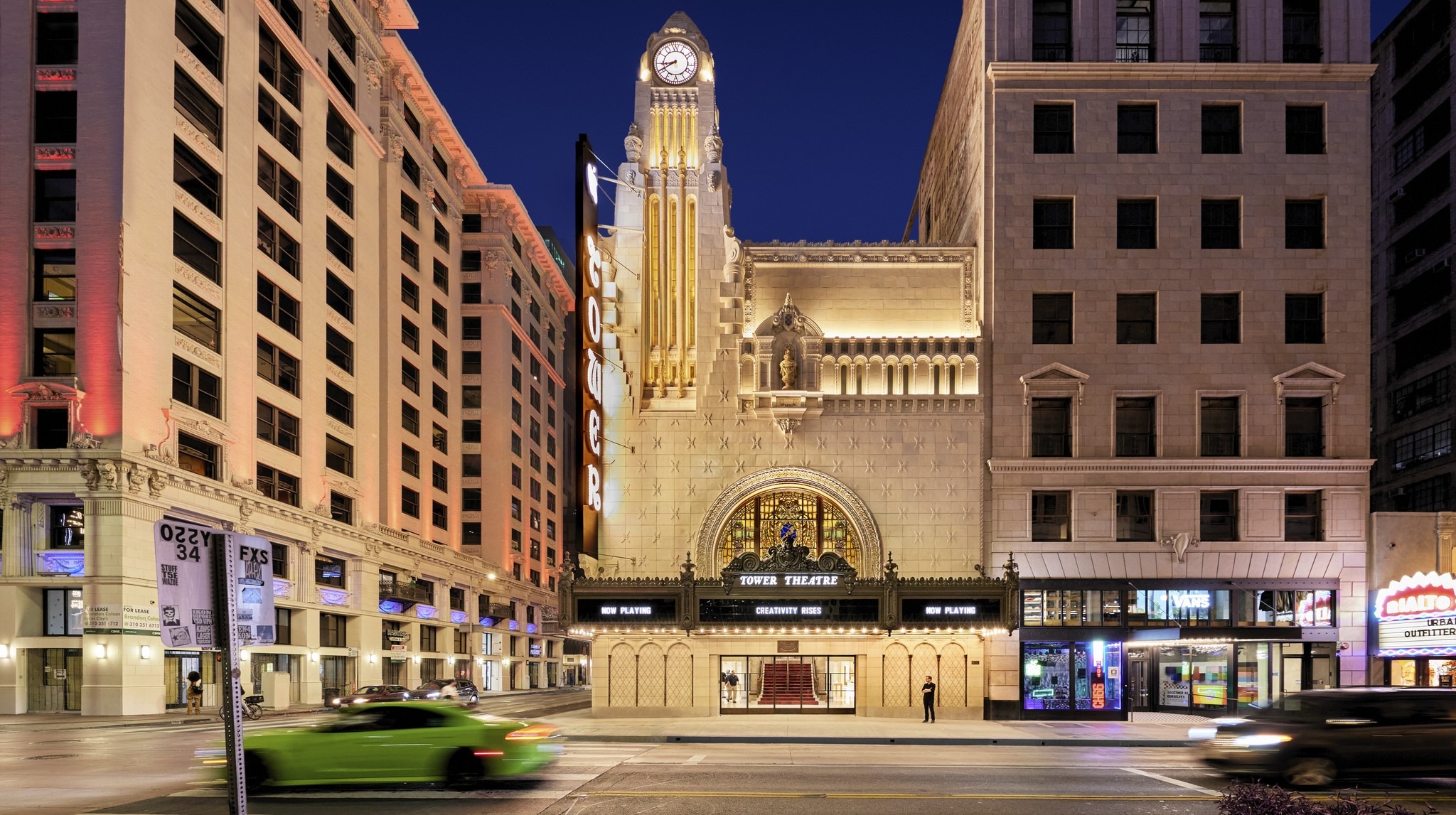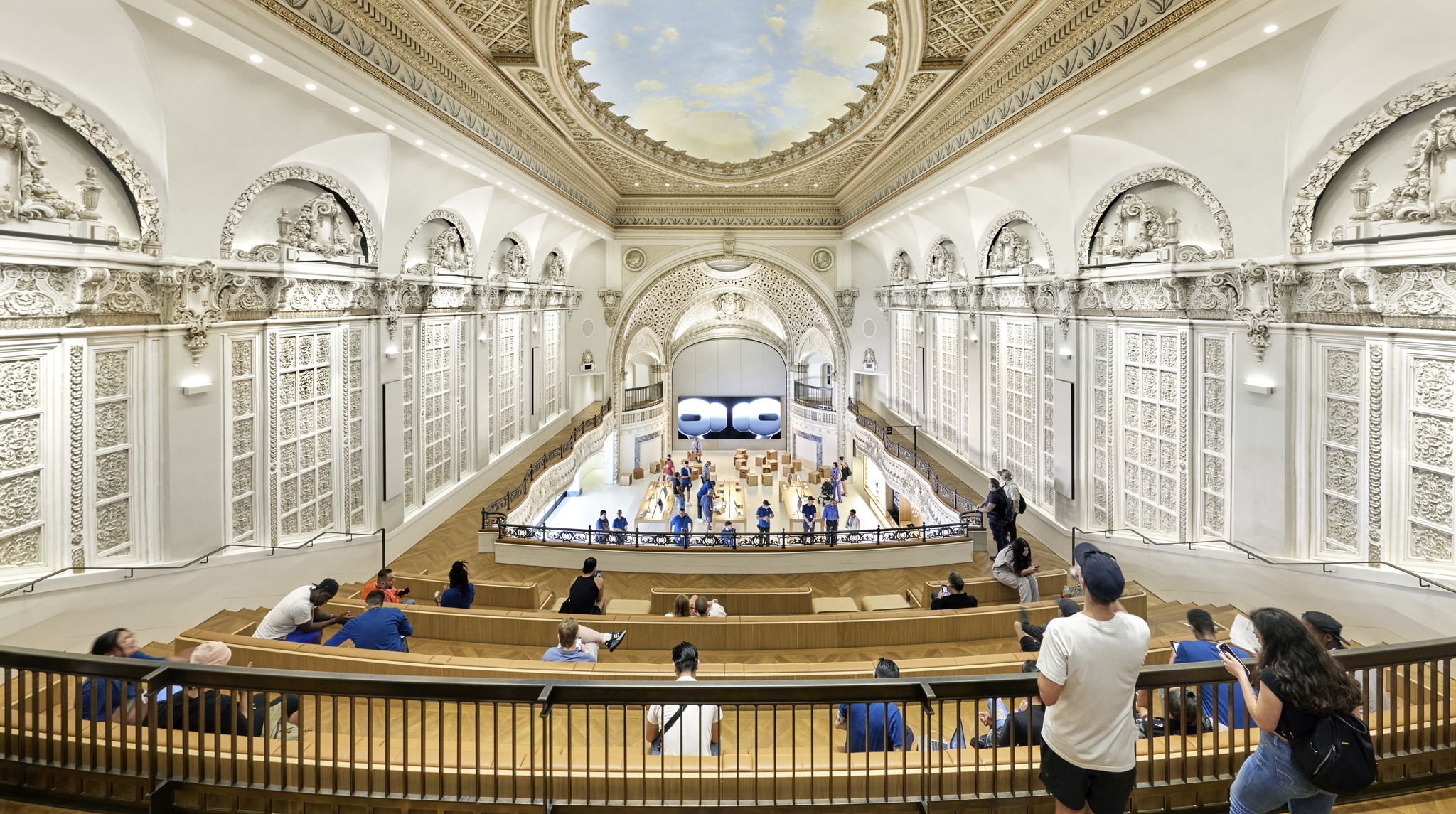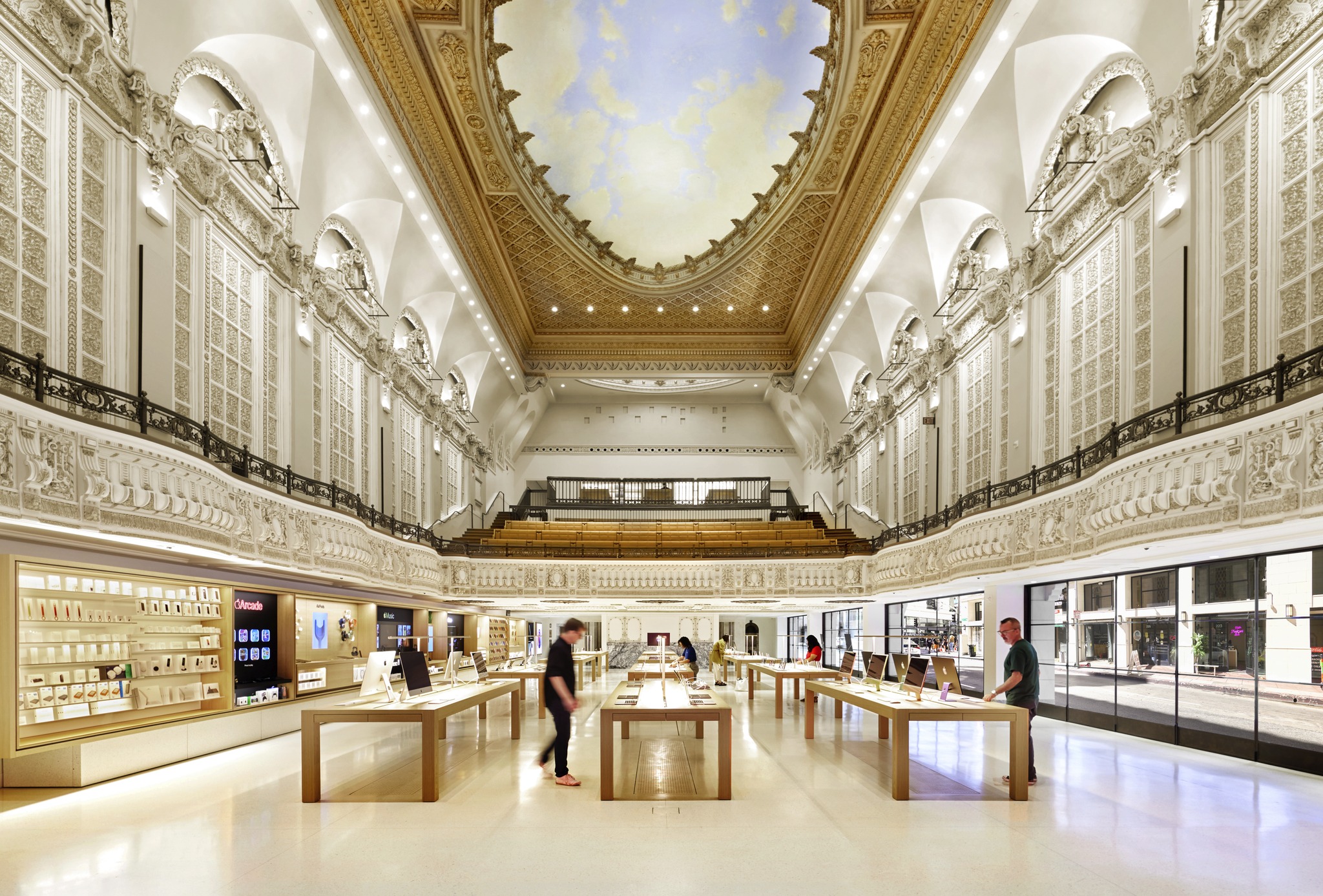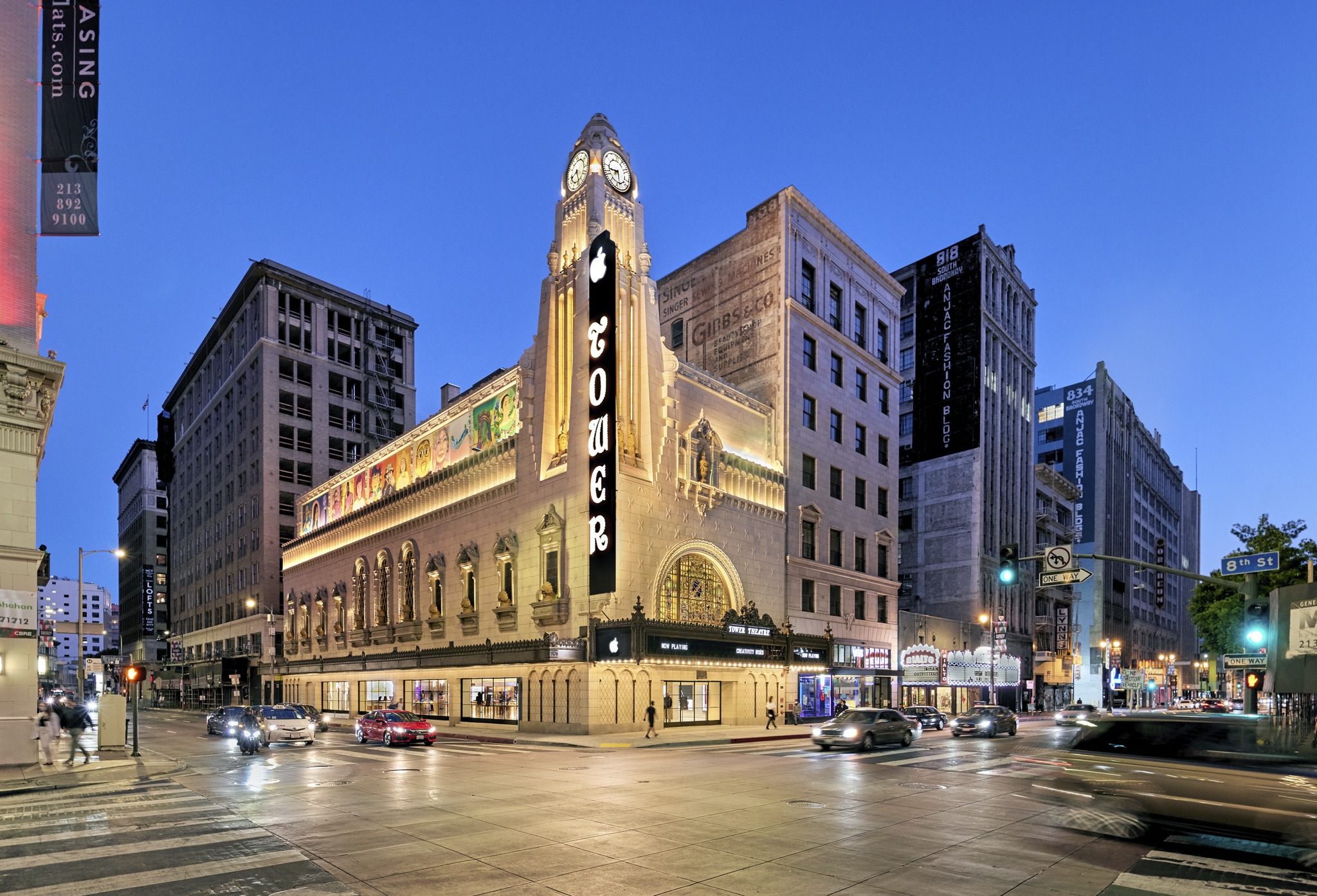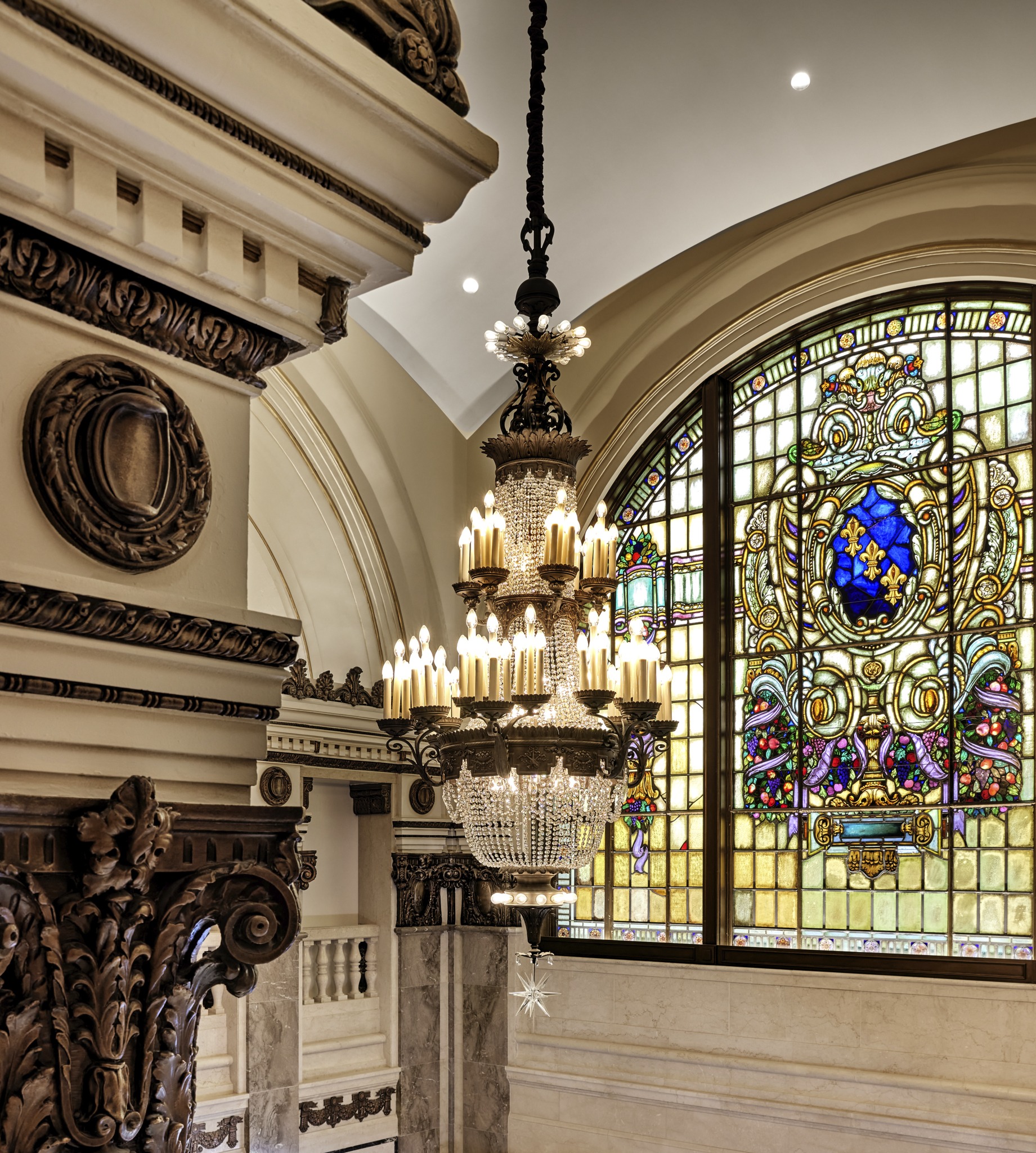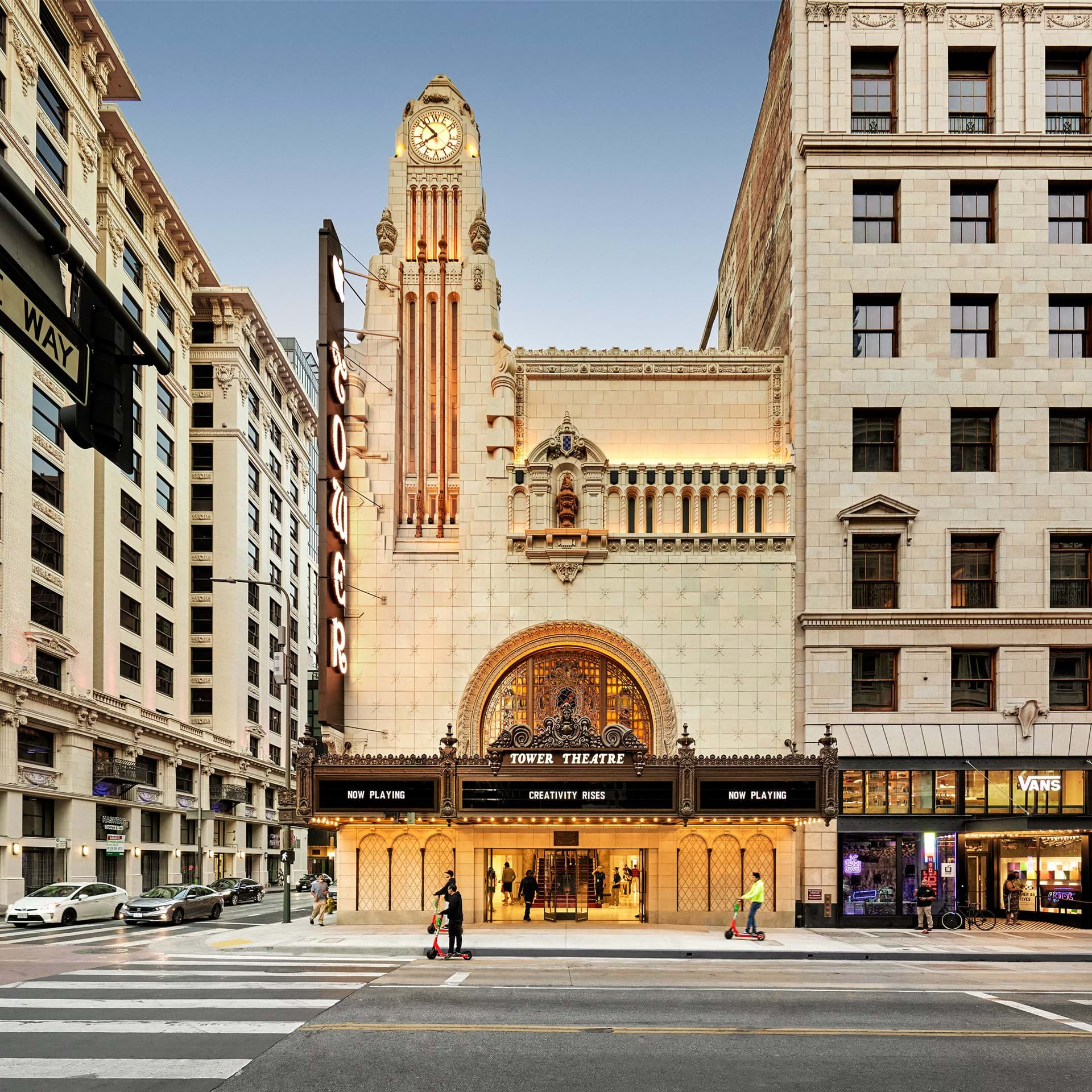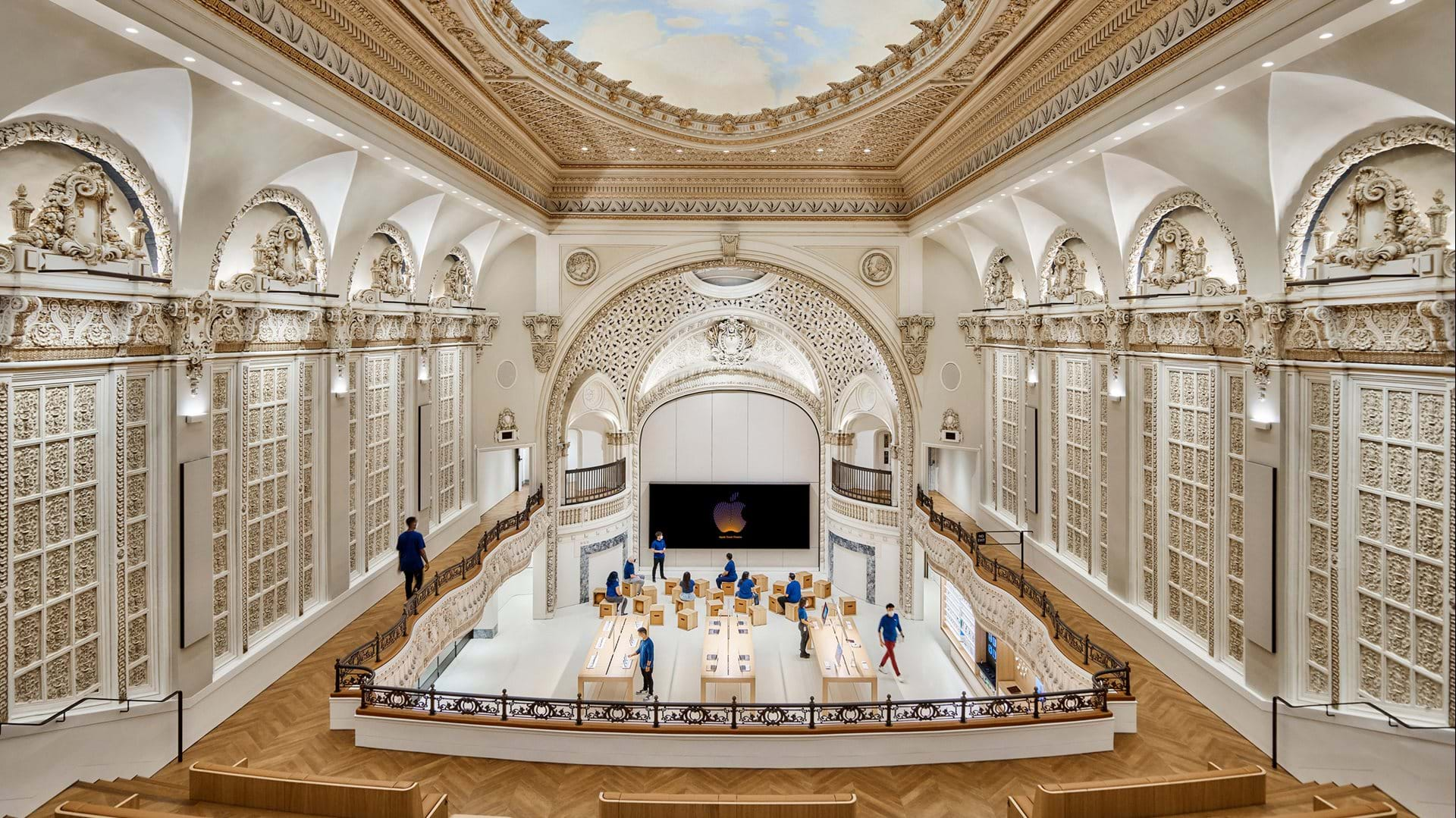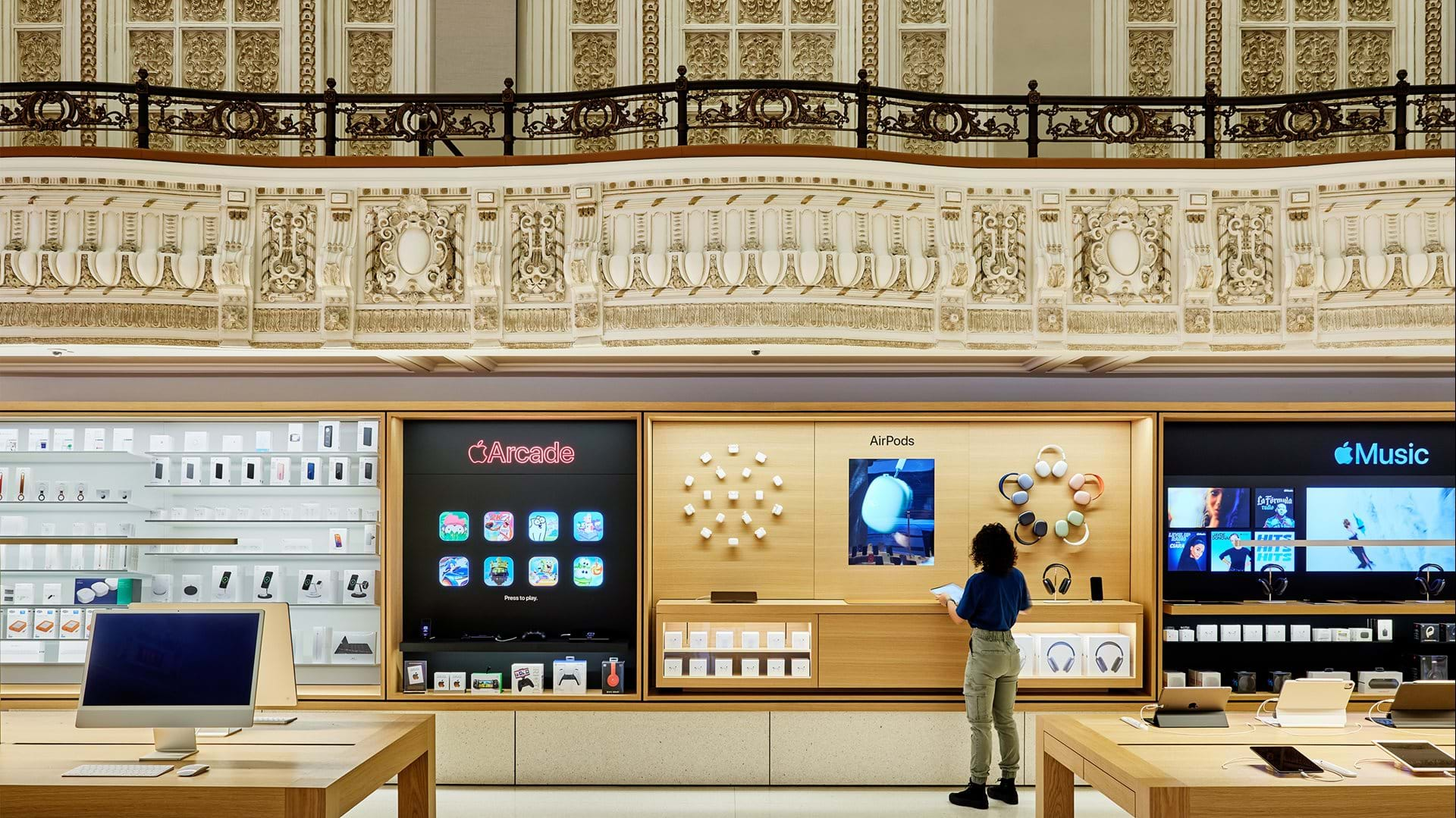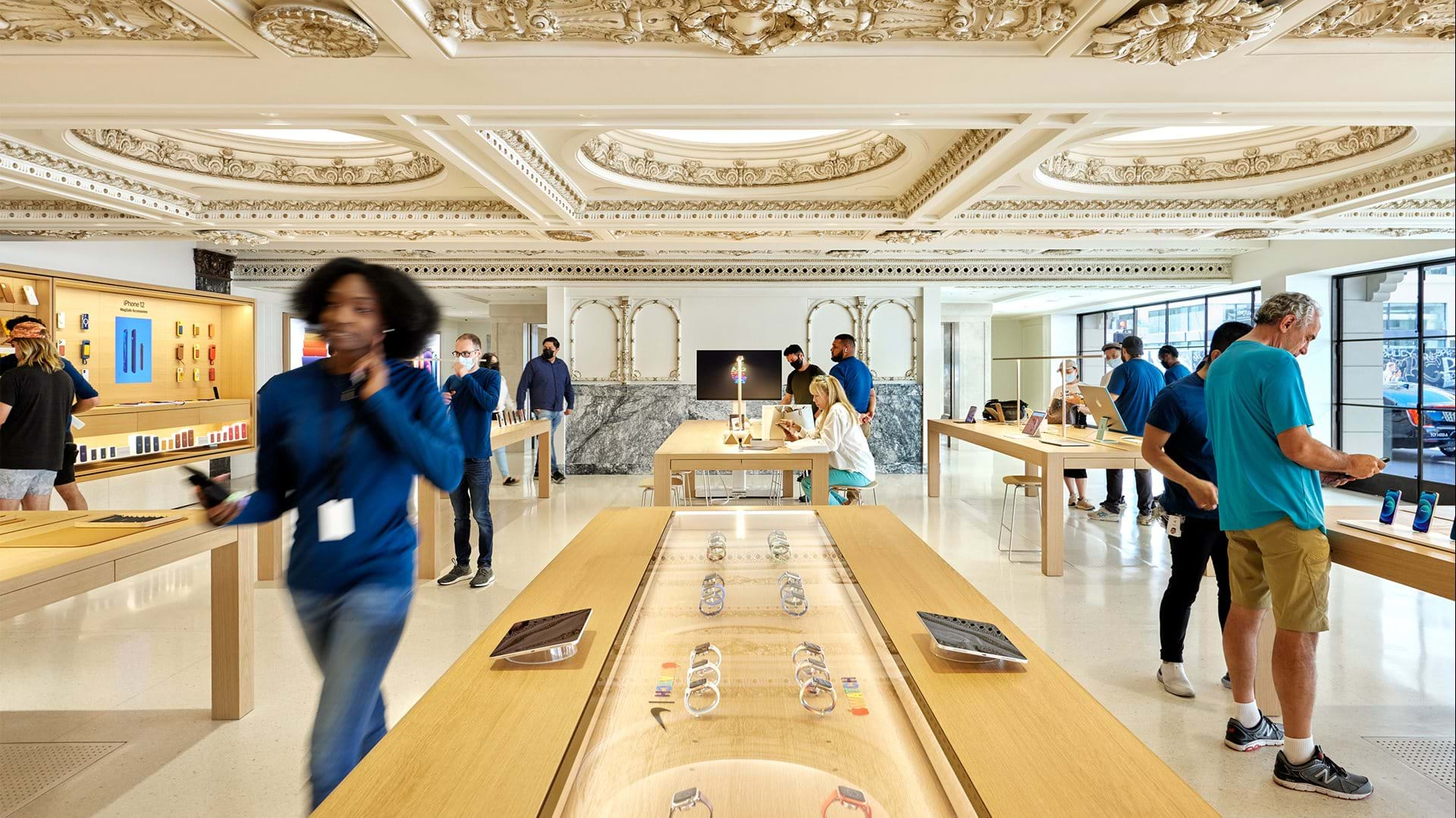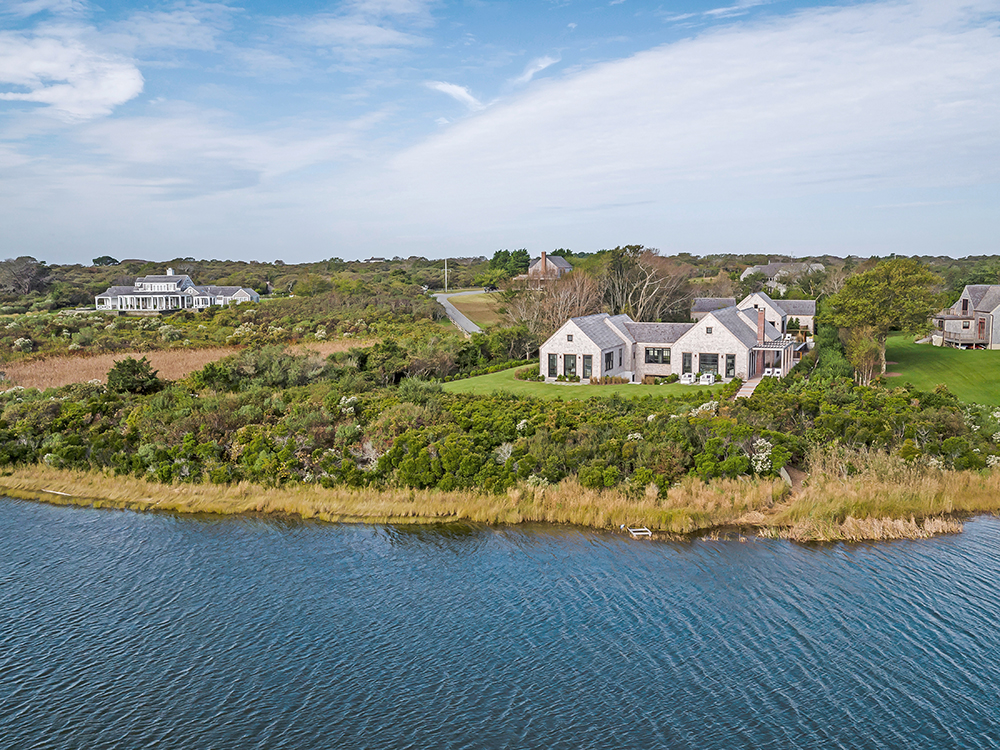The April 2023 issue of Traditional Building magazine arrived in my mailbox this morning, with a surprise. The cover story is a feature I wrote on the restoration of the Renaissance Revival-style Tower Theatre in Los Angeles, now Apple’s flagship operation in that city. A+A is pleased to post it here today:
By Michael Welton
On June 24, 2021, Apple’s newest store in Los Angeles premiered inside a renovated 1927-era theater. It’s a building that boasts a superb Hollywood cast—and script
Charles Lee designed the Tower Theatre in 1926 as the first in town to be built for talking pictures. It was sited on a lot just 50 feet by 153 feet, so the architect designed his first-of-many movie houses to soar straight up—by adding a 150-foot-tall clock tower.
He announced his new building in the October 9, 1926, edition of the L.A. Times: “The new theater will be of Class A construction,” he declared. “It will seat 900 persons … the architectural design will follow a modernized French motif.”
Actually, Lee designed his downtown theater on the southeast corner of Broadway and Eighth in the Renaissance Revival style, with French, Italian, and Moorish terra-cotta flourishes outside. Inside, the Palais Garnier in Paris, or Paris Opera House, offered French inspiration. It was innovative not just because of the sound provided by Vitaphone’s “pictures with a voice,” but also because it was one of the first theaters with air conditioning. “Leave your fan at home,” urged an opening-day Carrier ad in the Times.
It was designed also for mixed use, with an upscale retail component. “The Broadway side of the building will be constructed to accommodate high-class specialty shops,” Lee’s announcement added.
Construction began on March 26, 1927; the theater opened on October 12. Its first film was a silent—The Gingham Girl—but a legendary talkie, The Jazz Singer with Al Jolson, wasn’t far behind.
A building review in the Times was favorable, but noted the small, seven-foot-deep stage that eliminated vaudeville acts: “With its decorative motif carried out in the spirit of the French Renaissance, the new Tower Theatre… will be one of the loveliest of the small picture houses,” according to the Times. “Although it lifts its spire in the heart of the business section … it has a seating capacity of less than 1000 and will cater to those who like their movies straight, minus all vaudevillian extras.”
By the end of World War II, attendance was in decline. In 1946, Metropolitan Theatres subleased the building, renamed it the Music Hall, and began booking films there with other Music Halls in Beverly Hills and Hollywood.
In 1950 the theater was running only newsreels, with the imaginative new moniker of the Newsreel Theater. It later served as a general-run theater called Music Hall Downtown. A 1965 renovation ushered in a new marquee and vertical signage. Auditorium murals were removed, but new carpets, seats, paint, and sound system were added. Its center box office was taken out, and replaced with one on the south side near a new entrance.
Alas, in 1988 it closed its doors to regular showings and fell into disrepair, its clock hands destined to freeze in place. Still, it found new life as a backdrop for a number of well-known films, including The Mango Kings (1992), Fight Club (1999), Coyote Ugly (2000), and Mulholland Drive (2001).
A new lease on life
In 2018, Apple announced a plan to lease, renovate, and convert the Tower into its flagship store for L.A. Its design team worked closely with London-based Foster + Partners to preserve and restore it—and give it a new purpose. Gruen Associates served as local associate architect, with partner Deborah Gerod leading the charge.
The Genius Level on the balcony offers a complete snapshot of the theatre in all its restored glory
It made a statement. “Apple brings with it prestige, brand, and identity, and it anchors downtown—especially the Broadway district,” says Tiffany Nitsche, president of the Los Angeles Historic Theatre Foundation.
The design plan was comprehensive, with seismic strengthening, replacement of a tower cap removed after a 1971 earthquake, a newly ticking clock, and restoration of all interior marble, plaster, and paintings. Gallery space along the stairway to the basement now offers an educational experience, with historic photos and elements from the architects’ restoration.
“It was very sensitive—EverGreene Architectural Arts from Washington, D.C., worked on restoring the paintings,” she says. “One thing that was brilliant with Apple was that they were able to recreate works from plaster molds.”
The designers restored the exterior terra cotta and improved the marquees and Broadway Street elevation. They upgraded the theater’s accessibility, to assure the building will survive and serve the community into the future.
“It could go back to being a theater,” she says. “And it allows us the opportunity to show city council and developers that we don’t have to demolish a building to bring in something new.”
The street-level lobby greets visitors on entry, and opens up to a soaring volume at the main theater level, now a product display area. The auditorium is surrounded by arched bays and restored bronze, and features an array of Apple offerings. A renovated grand staircase leads to the upper levels, and two new elevators have been installed.
Those stairs and elevators deliver visitors to the balcony level, with the best seats in the house reserved for viewing Lee’s auditorium. At the top of the balcony is The Genius Level, just below the theater projectionist’s window. Seats outside are leather and theater-style, with integrated electrical and data points—a comfortable, tech-savvy space for relaxing while waiting for a Genius Bar support appointment. “What a great place to go when your product needs work,” Nitsche says. “And you can go in, plug in, and sit there all day to work if you want.”
The main level of the theatre has been transformed into a majestic display area.
The architects reinterpreted the dome of the theater’s ceiling with a fresco of California sunshine. Below it, the Forum space reinstates the theater’s screen under its proscenium arch. The Forum is home to “Today at Apple,” where free daily sessions led by Apple team members and local creatives provide inspiration and teach practical skills.
“Meet me in the Tower Lounge,” a buoyant 1927 ad once read for the then-new Tower Theatre. It’s an apt new slogan for L.A.’s Apple flagship today—in a building where a near-century-old tower clock is keeping time once more.
For more, go here.

